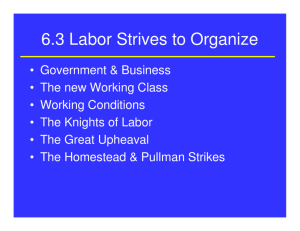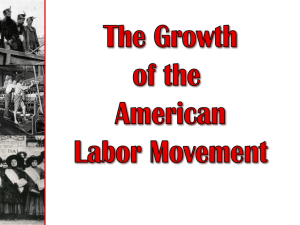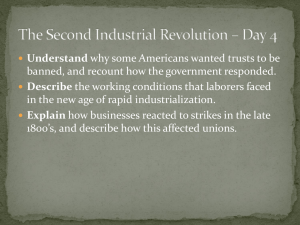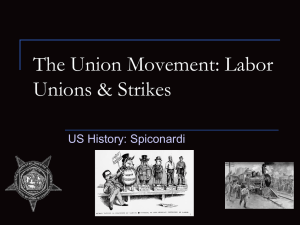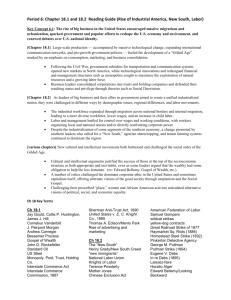2 - Cloudfront.net
advertisement
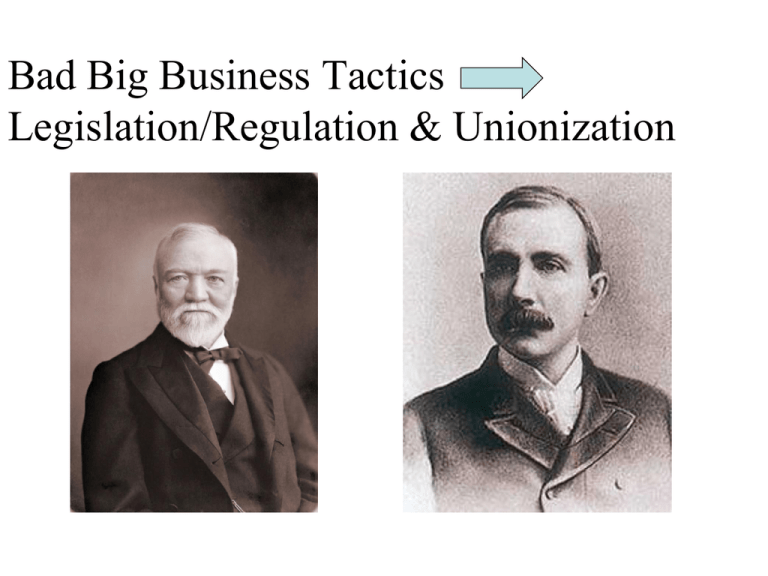
Bad Big Business Tactics Legislation/Regulation & Unionization Andrew Carnegie, 1835-1919 “When fate hands us a lemon, let’s try to make lemonade.” Scottish Immigrant Came to United States 1848, age 12 First jobs - At 18 - a clerk for the Superintendent the Pennsylvania Railroad * Impressed his boss - offered chance to purchase stock * Carnegie impressed by ability to earn from capital - builds investments At 24 - he was Superintendent of the Railroad Opens a New Steel Business - 1873: opens a steel mill - 1899: producing more steel than all of Britain - 1901: Sells out to U.S. Steel Carnegie’s Business Strategy 1. Worked to make products better and cheaper 2. Attracted good people with stock options 3. Control steel industry a. Vertical Integration “As I grow older, I pay less attention to what men say, I just watch what they do” Vertical Integration: See graphic on pg. 242 • control production bottom to top (your own company provides all “parts”) Horizontal Integration: • buy out competing producers (you are the only company offering a specific type of service) Social Darwinism Expanded upon Charles Darwin’s theory of the evolution where “survival of the fittest” was a natural law • Herbert Spencer suggested evolution in human society – the fittest rise to the top • Used to justify “laissez-faire” (hands-off) economics: econ. should not be regulated or interfered with - it followed natural laws Consistent with “Protestant work ethic” Material success = Sign of God’s grace John D. Rockefeller (July 8, 1839 – May 23, 1937) • American born “I believe in the dignity of labor, whether with head or hand; that the world owes no man a living but that it owes every man an opportunity to make a living.” Rockefeller and the Standard Oil Trust (Monopoly) Tactics 1. Paid very low wages 2. Drove competition out of business by a. selling at a loss b. buying out competitors’ supplies c. refusing to lease oil tankers to compet. d. arranging cheaper shipping with the railroad By 1879 Standard Oil was refining 90% of American oil, used its own tank car fleet, ships, docking facilities, barrel-making plants, depots, and warehouses. That’s what I call Vertical Integration! Robber Barons: businessmen and bankers who dominated their industries and became very wealthy, typically as a direct result of pursuing anti-competitive or unfair business practices Carnegie- steel Morgan- banker Rockefeller- oil Stanford- RR Vanderbilt- RR Gould- RR or Philanthropists? “Gospel of Wealth” - essay by Andrew Carnegie “…the duty of the man of wealth: first, to set an example of modest, unostentatious living, shunning display or extravagance; to provide moderately for the legitimate wants of those dependent upon him; and after doing so to consider all surplus revenues which come to him simply as trust funds which he is called upon to administer, and strictly bound as a matter of duty to administer in the manner which, in his judgment, is best calculated to produce the most beneficial results for the community—the man of wealth thus becoming the mere agent and trustee for his poorer brethren, bringing to their service his superior wisdom, experience, and ability to administer, doing for them better than they would or could do for themselves.... The man who dies rich… dies disgraced.” Government Reaction to “robber baron” Tactics Wanted to protect free market: fear big business stifling competition Passed Sherman Anti-trust Act, 1890 - made it illegal to form a trust that interfered with free trade between states or other countries - proved difficult to enforce, courts rejected majority of cases Problems in the workplace Terms of employment poor: 6-7 day weeks, 12+ hour days, no vacation, no sick leave Physical conditions poor: polluted and often dangerous Wages low: so low that millions of women and children forced to work Worker Reaction - Unions Name of Union Knights of Labor (Craft Unions) AFL (American Federation of Labor) (Industrial Unions) Example: ARU American Railway Union IWW International Workers of the World Date and Organizer Membership Goals/ Beliefs Tactics 1869, Uriah Stephens men, women, black, white, skilled, unskilled 8 hour day, equal pay for equal work arbitration, strike last resort 1886, Samuel Gompers 1893, Eugene V. Debs 1905, Eugene V. Debs skilled workers (male, white) wages, work hours, work conditions strikes major tactic male, skilled and unskilled workers wages, work hours, work conditions strikes major tactic male, skilled, unskilled, white, black Usual + international worker unity (socialist) strikes major tactic In 1905 radical unionists and socialists formed the Industrial Workers of the World (IWW) to organize unskilled labor and semi-skilled workers such as western miners, migrant farm workers, lumbermen, and some eastern textile workers. IWW members, known as Wobblies, pasted small posters like this one on fence posts or in RR boxcars to call attention to their cause. 1. What message do the images in this poster convey to you? 2. What do you find the most persuasive about this poster? Why? 3. Why do you think IWW posters were often called “silent agitators”? Strikes become violent (Great- Hay- Home- Pull) Government and business respond with force - strikes undermine the economic system (slows production) - fear communism and/or anarchy Sherman Anti-trust Act works in favor of business - businesses claimed strikes interfered with interstate commerce and gov’t would send in troops to break up strike Great Strike of 1877 - 80,000 railroad workers strike - Shut down most RR traffic for week President Hayes authorizes use of federal troops to stop the violence Haymarket Riot, May 4, 1886 - 3,000 gather to protest police killing of striker - police sent in to disperse rioters someone throws bomb into police line - 7 police killed Public opinion begins to turn against unions and strikes, connecting them to violence Homestead Strike, 1892 - At Carnegie Steel Plant in Homestead, PA Supervisor announces wage cuts, calls in Pinkerton detectives to protect strike breakers (“scabs”) Pinkerton detectives battle strikers and townspeople12 die Union loses support Pullman’s Model Town… George M. Pullman’s “Model Town” Pullman’s factory builds high quality RR cars Pullman provided… Apartments And expected… Doctors Sports fields Shops Rent No Alcohol Letters from the citizens of Pullman “One fine morning a number of men...will knock at your door and tell you that they have come to whitewash your house. They will not bother you with questions...but they just go in and do it...all charges for repairs....will be DEDUCTED FROM YOUR WAGES next pay day. You would have liked to wait another week...because you wanted to buy a pair of shoes for your boy. The company can't care about that!” “Pullman was all very well as an employer, but to live and breathe and have one's being in Pullman was a bit too much. Residents paid rent to the Pullman Company, they bought gas of the Pullman Company, they walked on streets owned in fee simple by the Pullman Company, they paid water-tax to the Pullman Company...They sent their children to Pullman's school, attended Pullman's church, looked at but dared not enter Pullman's hotel with its private bar, for that was the limit. Pullman did not sell them their grog [liquor]...The lives of the working men were bounded on all sides by the Pullman Company; Pullman was the horizon in every direction.” Pullman Strike, 1893 Pullman lays off half of workers, cuts wages of rest - refuses to reduce rent ARU, with Eugene Debs as spokesman, wants arbitration - Pullman refuses Pullman hires strikebreakers “scabs” President Cleveland orders in federal troops Women and Unions Leading figure: Mary Harris Jones -supported strikes, help start unions - showed horrors of child laborers -lead to restrictions in child labor Women’s Unions form ILGWU (Internat’l Ladies Garment Workers Union) Triangle Shirtwaist Factory Factory located on 8th, 9th, and 10th floors of Asch Building in New York City March 25, 1911 about 4:45 PM fire breaks out on 8th floor Most doors were locked and elevator soon failed Unable to escape, young women burned to death, died of smoke inhalation, or jumped to their death It took only about half an hour to bring the fire under control This is what they found inside… The final count: 146 young teenage women dead Aftermath Rose Schneiderman, a young union organizer, spoke for many workers when she said: “I would be a traitor to those poor burned bodies, if I were to come here to talk good fellowship. We have tried you good people of the public—and we have found you wanting.” Public fury over the deaths and the acquittal of the building’s owners led to thirty-six new laws reforming the state’s labor code. Please answer the questions in your notebook 1. Do you think the tycoons we’ve talked about (Carnegie and Rockefeller) are ruthless robber barons or just good business men (captains of industry)? 2. If the government had supported unions instead of management (factory owners) in the late 19th century, how might the lives of workers have been different? 3. Do you think more gov’t involvement could’ve slowed down the industrialization of America? How or why?
